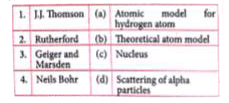Complete Solutions to ADDITIONAL QUESTIONS SOLVED (SHORT ANSWER QUESTIONS - 1 (3 MARKS)) of chapter KINEMATICS of Class 11 book with complete answers and questions
| Class 11 | PHYSICS |
| Chapter | KINEMATICS |
| FULL MARKS | ADDITIONAL QUESTIONS SOLVED (SHORT ANSWER QUESTIONS - 1 (3 MARKS)) |
| Number Of Questions | 14 |
| Academic Year | 2023-24 |
Is the acceleration of a particle in circular motion not always towards the centre? Explain.
View SolutionDraw (a) acceleration - time (b) velocity - time (c) position - time graphs representing motion of an object under free fall. Neglect air resistance.
View SolutionMatch the columns

View SolutionFor an object projected upward with a velocity `v_(0)` which comes back to the same point after some time, draw
(i) Acceleration-time graph
(ii) Position-time graph
(iii) Velocity-time graph
View SolutionThe acceleration of a particle in `ms^(-1)` is given by `a=3t^(2)+2t+2` where timer is in second If the particle starts with a velocity `v=2ms^(-1)` at t=0 then find the velocity at the end of 2s.
View SolutionAt what angle do the two forces (P+Q) and (P-Q) act so that the resultant is `sqrt(3P^(2)+Q^(2))`?
View SolutionA car moving along a straight highway with a speed of 126 kilometre per hour is brought to a stop within a distance of 200m. What is the retardation of the car (assumed uniform) and how long does it taken for the car to stop?
View SolutionIs the acceleration of a particle in circular motion not always towards the centre? Explain.
View SolutionEstimate the mean free path and collision frequency of a nitrogen molecule in a cylinder containing nitrogen at 2.0 atm and temperature 17°C. Take the radius of a nitrogen molecule to be roughly 1.0 A. Compare the collision time with the time the molecule moves freely between two successive collisions (Molecular mass of N2 = 28.0 u).
View SolutionThe velocity time graph for a particle is shown in figure. Draw acceleration time graph from it

View SolutionFor an object projected upward with a velocity `v_(0)` which comes back to the same point after some time, draw
(i) Acceleration-time graph
(ii) Position-time graph
(iii) Velocity-time graph

View SolutionThree vessels of equal capacity have gases at the same temperature and pressure. The first-vessel contains neon (monoatomic), the second contains chlorine (diatomic), and the third contains uranium hexafluoride (polyatomic). Do the vessels contain an equal number of respective molecules? Is the root mean square speed of molecules the same in the three cases? If not, in which case is υrms the largest?
View SolutionTwo metallic spheres having same shape and size, but one of Cu and other of Al, are both placed in an identical electric field. In which metallic sphere will more charge be induced?
View SolutionWhy does a nylon or plastic comb get electrified on combing or rubbing but a metal spoon does not?
View Solution
ADDITIONAL QUESTIONS SOLVED (SHORT ANSWER QUESTIONS - 1 (3 MARKS)) questions and complete solutions for chapter KINEMATICS of FULL MARKS PHYSICS (TAMIL ENGLISH) of Class 11
All Exercises from FULL MARKS Class 11 PHYSICS KINEMATICS
- ADDITIONAL QUESTIONS SOLVED (I.MULTIPLE CHOICE)
- ADDITIONAL QUESTIONS SOLVED (LONG ANSWER QUESTIONS)
- ADDITIONAL QUESTIONS SOLVED (NUMERICAL QUESTIONS)
- ADDITIONAL QUESTIONS SOLVED (SHORT ANSWER QUESTIONS (1 MARK))
- ADDITIONAL QUESTIONS SOLVED (SHORT ANSWER QUESTIONS - 1 (2 MARKS))
- ADDITIONAL QUESTIONS SOLVED (SHORT ANSWER QUESTIONS - 1 (3 MARKS))
- IN-TEXT SOLVED EXAMPLES
- TEXTUAL QUESTIONS SOLVED (LONG ANSWER QUESTIONS)
- TEXTUAL QUESTIONS SOLVED (MULTIPLE CHOICE QUESTIONS:)
- TEXTUAL QUESTIONS SOLVED (NUMERICAL QUESTIONS)
- TEXTUAL QUESTIONS SOLVED (SHORT ANSWER QUESTIONS)